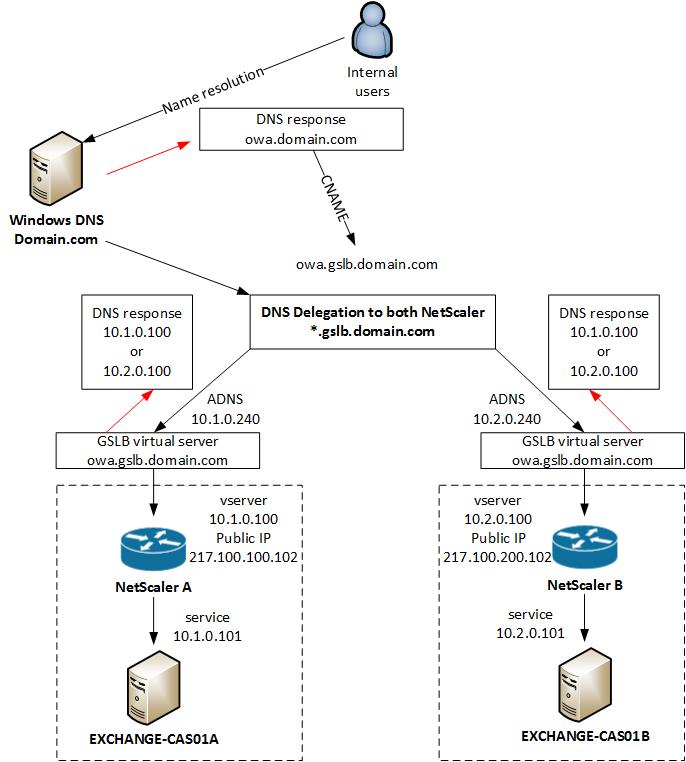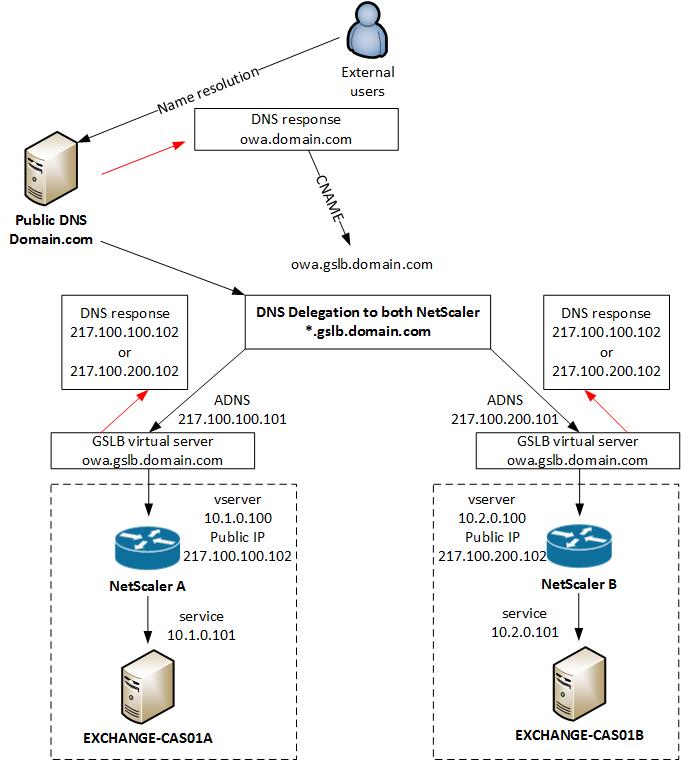Bin some month since I started working with Citrix NetScaler and so far I really like the NetScaler. I will not go into the deep how Global Server Load Balancing (GSLB) works and only explain my configuration. I use Exchange OWA as an example for GSLB, I will also not explain how to set-up a virtual server for Exchange OWA, please have a look at my previous blog post: NetScaler Exchange 2013 Load Balancing.
In my configuration I will use the same GSLB virtual server for internal and external access to Exchange OWA. The NetScaler see’s if you are coming from the internal network and give you a private IP address back, or when you are external you get a public IP address back for the same DNS entry.
Internal GSLB

External GSLB

Before you start you have to delegate a Subdomains in Microsoft DNS or BIND for Global Server Load Balancing on a NetScaler Appliance, more information how to do that you find here: http://support.citrix.com/article/CTX121713
VPX A
Enable GSLB on the NetScaler in location A and configure sites and ADNS service
enable ns feature GSLB add gslb site site-A 10.1.0.200 add gslb site site-B 10.2.0.200 set ns rpcNode 10.1.0.200 -password ***key*** -srcIP * -secure YES set ns rpcNode 10.2.0.200 -password ***key*** -srcIP * -secure YES add service service-ADNS_53 10.1.0.240 ADNS 53 -gslb NONE -maxClient 0 -maxReq 0 -cip DISABLED -usip YES -useproxyport NO -sp OFF -cltTimeout 120 -svrTimeout 120 -CustomServerID "\"None\"" -CKA NO -TCPB NO -CMP NO add service service-ADNS_TCP53 10.1.0.240 ADNS_TCP 53 -gslb NONE -maxClient 0 -maxReq 0 -cip DISABLED -usip YES -useproxyport YES -sp OFF -cltTimeout 180 -svrTimeout 360 -CustomServerID "\"None\"" -CKA NO -TCPB NO -CMP NO add dns addRec ns01-a.gslb.domain.com 217.100.100.101 add dns soaRec gslb.domain.com -originServer ns01-a.gslb.domain.com -contact hostmaster.gslb.domain.com add dns nsRec gslb.domain.com ns01-a.gslb.domain.com -TTL 300 add dns addRec ns01-a.gslb.domain.com 217.100.100.101 add dns zone gslb.domain.com -proxyMode NO
VPX B
Enable GSLB on the NetScaler in location B and configure sites and ADNS service
enable ns feature GSLB add gslb site site-A 10.1.0.200 add gslb site site-B 10.2.0.200 set ns rpcNode 10.1.0.200 -password ***key*** -srcIP * -secure YES set ns rpcNode 10.2.0.200 -password ***key*** -srcIP * -secure YES add service service-ADNS_53 10.2.0.240 ADNS 53 -gslb NONE -maxClient 0 -maxReq 0 -cip DISABLED -usip YES -useproxyport NO -sp OFF -cltTimeout 120 -svrTimeout 120 -CustomServerID "\"None\"" -CKA NO -TCPB NO -CMP NO add service service-ADNS_TCP53 10.2.0.240 ADNS_TCP 53 -gslb NONE -maxClient 0 -maxReq 0 -cip DISABLED -usip YES -useproxyport YES -sp OFF -cltTimeout 180 -svrTimeout 360 -CustomServerID "\"None\"" -CKA NO -TCPB NO -CMP NO add dns addRec ns01-b.gslb.domain.com 217.100.200.101 add dns soaRec gslb.domain.com -originServer ns01-b.gslb.domain.com -contact hostmaster.gslb.domain.com add dns nsRec gslb.domain.com ns01-b.gslb.domain.com -TTL 300 add dns addRec ns01-b.gslb.domain.com 217.100.200.101 add dns zone gslb.domain.com -proxyMode NO
VPX A
Configure GSLB service and virtual server in location A
add server vserver-EXCHANGE-OWA-A 10.1.0.100 add server vserver-EXCHANGE-OWA-B 10.2.0.100 add gslb vserver vserver-GSLB-EXCHANGE-OWA SSL -backupLBMethod ROUNDROBIN -tolerance 0 -EDR ENABLED -appflowLog DISABLED set gslb vserver vserver-GSLB-EXCHANGE-OWA -backupLBMethod ROUNDROBIN -tolerance 0 -EDR ENABLED -appflowLog DISABLED add gslb service service-GSLB-EXCHANGE-OWA-A_443 vserver-EXCHANGE-OWA-A SSL 443 -publicIP 217.100.100.102 -publicPort 443 -maxClient 0 -siteName site-A -cltTimeout 180 -svrTimeout 360 -downStateFlush DISABLED add gslb service service-GSLB-EXCHANGE-OWA-B_443 vserver-EXCHANGE-OWA-B SSL 443 -publicIP 217.100.200.102 -publicPort 443 -maxClient 0 -siteName site-B -cltTimeout 180 -svrTimeout 360 -downStateFlush DISABLED bind gslb vserver vserver-GSLB-EXCHANGE-OWA_443 -serviceName service-GSLB-EXCHANGE-OWA-A_443 bind gslb vserver vserver-GSLB-EXCHANGE-OWA_443 -serviceName service-GSLB-EXCHANGE-OWA-B_443 bind gslb vserver vserver-GSLB-EXCHANGE-OWA_443 -domainName owa.gslb.domain.com -TTL 5 -sitedomainTTL 300 bind gslb service service-GSLB-EXCHANGE-OWA-D_443 -monitorName https bind gslb service service-GSLB-EXCHANGE-OWA-C_443 -monitorName https
VPX B
Configure GSLB service and virtual server in location B
add server vserver-EXCHANGE-OWA-A 10.1.0.100 add server vserver-EXCHANGE-OWA-B 10.2.0.100 add gslb vserver vserver-GSLB-EXCHANGE-OWA SSL -backupLBMethod ROUNDROBIN -tolerance 0 -EDR ENABLED -appflowLog DISABLED set gslb vserver vserver-GSLB-EXCHANGE-OWA -backupLBMethod ROUNDROBIN -tolerance 0 -EDR ENABLED -appflowLog DISABLED add gslb service service-GSLB-EXCHANGE-OWA-A_443 vserver-EXCHANGE-OWA-A SSL 443 -publicIP 217.100.100.102 -publicPort 443 -maxClient 0 -siteName site-A -cltTimeout 180 -svrTimeout 360 -downStateFlush DISABLED add gslb service service-GSLB-EXCHANGE-OWA-B_443 vserver-EXCHANGE-OWA-B SSL 443 -publicIP 217.100.200.102 -publicPort 443 -maxClient 0 -siteName site-B -cltTimeout 180 -svrTimeout 360 -downStateFlush DISABLED bind gslb vserver vserver-GSLB-EXCHANGE-OWA_443 -serviceName service-GSLB-EXCHANGE-OWA-A_443 bind gslb vserver vserver-GSLB-EXCHANGE-OWA_443 -serviceName service-GSLB-EXCHANGE-OWA-B_443 bind gslb vserver vserver-GSLB-EXCHANGE-OWA_443 -domainName owa.gslb.domain.com -TTL 5 -sitedomainTTL 300 bind gslb service service-GSLB-EXCHANGE-OWA-A_443 -monitorName https bind gslb service service-GSLB-EXCHANGE-OWA-B_443 -monitorName https
Now you need to create an DNS view because we assign the public IP to the GSLB service and everybody gets the public IP as DNS response. With the internal DNS view, internal users get the internal private IP address back.
VPX A
add dns view view-INTERNAL add dns action action-DNS-INTERNAL ViewName -viewName view-INTERNAL add dns policy policy-DNS-INTERNAL "client.IP.SRC.IN_SUBNET(10.0.0.0/8)" action-DNS-INTERNAL bind dns global policy-DNS-INTERNAL 100 -gotoPriorityExpression END -type REQ_DEFAULT bind gslb service service-GSLB-EXCHANGE-OWA-A_443 -viewName view-INTERNAL 10.1.0.100 bind gslb service service-GSLB-EXCHANGE-OWA-B_443 -viewName view-INTERNAL 10.2.0.100
VPX B
add dns view view-INTERNAL add dns action action-DNS-INTERNAL ViewName -viewName view-INTERNAL add dns policy policy-DNS-INTERNAL "client.IP.SRC.IN_SUBNET(10.0.0.0/8)" action-DNS-INTERNAL bind dns global policy-DNS-INTERNAL 100 -gotoPriorityExpression END -type REQ_DEFAULT bind gslb service service-GSLB-EXCHANGE-OWA-A_443 -viewName view-INTERNAL 10.1.0.100 bind gslb service service-GSLB-EXCHANGE-OWA-B_443 -viewName view-INTERNAL 10.2.0.100
That’s it from the configuration for GSLB, quite easy and straight forward 🙂
Here you find a very detailed PDF from Citrix about GSLB: http://support.citrix.com/servlet/KbServlet/download/22506-102-671576/gslb-primer_FINAL_1019.pdf
How did you get your ADNS service to listen on both public and private IP addresses?
The ADNS service is automatically replying with DNS requests to both public and private IP addresses.
Over the DNS view you control if the NetScaler replies with a public or private IP, I think I forgot to show the config for the external view:
add dns view view-EXTERNAL
add dns action action-DNS-EXTERNAL ViewName -viewName view-EXTERNAL
add dns policy policy-DNS-EXTERNAL “CLIENT.IP.SRC.IN_SUBNET(10.0.0.0/8).NOT && CLIENT.UDP.DNS.DOMAIN.EQ(\”owa.gslb.domain.com\”)” action-DNS-EXTERNAL
bind dns global policy-DNS-EXTERNAL 200 -gotoPriorityExpression END -type REQ_DEFAULT
I hope that will help you
I’m keen to understand, if you had a PAT\NAT setup from the Public IP (for ADNS services) to your ADNS listener service running on Private IP? Thanks for the insight, good blog!
Also, did you get this scenario (DNS Views) in an Active-Passive GSLB setup? I.e. You wouldn’t want the NetScaler to handout the Private IP (VIP) of the REMOTE until a Fail-Over has occurred! Hope it makes sense
Yes I have a static 1:1 NAT to the private IP of my ADNS listener.
You also use this scenario if you do Active-Passive GSLB same configuration but you change the weight of the GSLB services.
What IP the NetScaler gives out, you manage by DNS views what view matches to your policy. That is also the reason why you configure a public IP in the GSLB service configuration, the ADNS listener replies per default then always with the public IP until a DNS view changes this.
Example:
add gslb service service-GSLB-EXCHANGE-OWA-A_443 vserver-EXCHANGE-OWA-A SSL 443 -publicIP 217.100.100.102 -publicPort 443 -maxClient 0 -siteName site-A -cltTimeout 180 -svrTimeout 360 -downStateFlush DISABLED
Great article for OWA GSLB. Does this also work for GSLB for Outlook Anywhere or Active-Sync? thanks
Yes this works both, GSLB is in the end DNS based and redirect you to the right virtual server on the NetScaler and keep you persistent there.
That config I run on OWA, Outlook Anywhere and Active Sync. Works very good 🙂
Thank you for this guide. I have a question about the DNS subdomain delegation. In your internal example:
1. Create a CNAME for owa.domain.com that is aliased to owa.gslb.domain.com
2. Then DNS delegation to both NS ADNS services. I just want to confirm the ADNS as below is correct:
siteA.owa.gslb.domain.com (for ADNS 10.1.0.240)
siteB.owa.gslb.domain.com (for ADNS 10.2.0.240)
Thanks for your help in advance
Sorry for the late reply.
You this is correct you delegate to ADNS IPs of each NetScaler
Sorry if this has been answered before. If an external client request resolution and gets an IP of 217.100.100.102 which it proceeds to cache. If site A goes down is there a mechanism for the client to be warned to stop using the cached IP and query again? I understand that when it queries again it will get the IP of site B.
I can think of really low TTL as one mechanism.
This is always a problem with GSLB because it is DNS based and client caching could result that the requests hitting the wrong datacenter.
How to get round this, is a short TTL as you said, Default is 5s if I remember correctly.
The Citrix NetScaler has another cool feature to redirect/tunnel the request to the right location if you have an existing session somewhere. It keeps a global connection table and if you’re hitting the wrong location your connection is internally forwarded to the NetScaler u were using before if there is no fault.
But if a site goes down completely your tcp sessions are broken and you need to rely on a short TTL as mentioned and that your application recovers automatically, for MS exchange and Outlook this is very seamless but normal website this maybe less good.
But overall GSLB is a good way to equally distribute your traffic and for site redundancy.
I understand. Thank you for your response and for the great article.
what is this entry for 10.2.0.240 i do not see this IP in your network diagram
add service service-ADNS_53 10.2.0.240 ADNS 53 -gslb NONE -maxClient 0 -maxReq 0 -cip DISABLED -usip YES -useproxyport NO -sp OFF -cltTimeout 120 -svrTimeout 120 -CustomServerID “\”None\”” -CKA NO -TCPB NO -CMP NO
add service service-ADNS_TCP53 10.2.0.240 ADNS_TCP 53 -gslb NONE -maxClient 0 -maxReq 0 -cip DISABLED -usip YES -useproxyport YES -sp OFF -cltTimeout 180 -svrTimeout 360 -CustomServerID “\”None\”” -CKA NO -TCPB NO -CMP NO